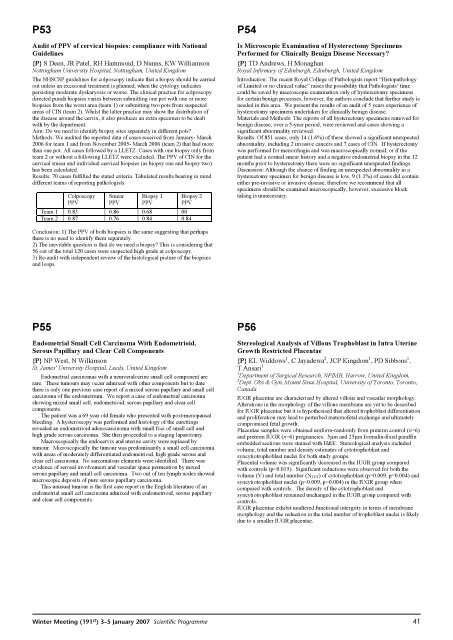2007 Winter Meeting - London - The Pathological Society of Great ...
2007 Winter Meeting - London - The Pathological Society of Great ...
2007 Winter Meeting - London - The Pathological Society of Great ...
- No tags were found...
You also want an ePaper? Increase the reach of your titles
YUMPU automatically turns print PDFs into web optimized ePapers that Google loves.
P53Audit <strong>of</strong> PPV <strong>of</strong> cervical biopsies: compliance with NationalGuidelines{P} S Deen, JR Patel, RH Hammond, D Nunns, KW WilliamsonNottingham University Hospital, Nottingham, United Kingdom<strong>The</strong> NHSCSP guidelines for colposcopy indicate that a biopsy should be carriedout unless an excisional treatment is planned, when the cytology indicatespersisting moderate dyskaryosis or worse. <strong>The</strong> clinical practice for colposcopydirected punch biopsies varies between submitting one pot with one or morebiopsies from the worst area (team 1) or submitting two pots from suspectedareas <strong>of</strong> CIN (team 2). Whilst the latter practice may show the distribution <strong>of</strong>the disease around the cervix, it also produces an extra specimen to be dealtwith by the department.Aim: Do we need to identify biopsy sites separately in different pots?Methods: We audited the reported data <strong>of</strong> cases received from January- March2006 for team 1 and from November 2005- March 2006 (team 2) that had morethan one pot. All cases followed by a LLETZ. Cases with one biopsy only fromteam 2 or without a following LLETZ were excluded. <strong>The</strong> PPV <strong>of</strong> CIN for thecervical smear and individual cervical biopsies (as biopsy one and biopsy two)has been calculated.Results: 70 cases fulfilled the stated criteria. Tabulated results bearing in minddifferent teams <strong>of</strong> reporting pathologists.ColposcopyPPVSmearPPVBiopsy 1PPVBiopsy 2PPVTeam 1 0.83 0.86 0.68 00Team 2 0.87 0.76 0.84 0.84P54Is Microscopic Examination <strong>of</strong> Hysterectomy SpecimensPerformed for Clinically Benign Disease Necessary?{P} TD Andrews, H MonaghanRoyal Infirmary <strong>of</strong> Edinburgh, Edinburgh, United KingdomIntroduction: <strong>The</strong> recent Royal College <strong>of</strong> Pathologists report “Histopathology<strong>of</strong> Limited or no clinical value” raises the possibility that Pathologists’ timecould be saved by macroscopic examination only <strong>of</strong> hysterectomy specimensfor certain benign processes, however, the authors conclude that further study isneeded in this area. We present the results <strong>of</strong> an audit <strong>of</strong> 5 years experience <strong>of</strong>hysterectomy specimens undertaken for clinically benign disease.Materials and Methods: <strong>The</strong> reports <strong>of</strong> all hysterectomy specimens removed forbenign disease, over a 5-year period, were reviewed and cases showing asignificant abnormality reviewed.Results: Of 851 cases, only 14 (1.6%) <strong>of</strong> these showed a significant unexpectedabnormality, including 2 invasive cancers and 7 cases <strong>of</strong> CIN. If hysterectomywas performed for menorrhagia and was macroscopically normal, or if thepatient had a normal smear history and a negative endometrial biopsy in the 12months prior to hysterectomy there were no significant unexpected findings.Discussion: Although the chance <strong>of</strong> finding an unexpected abnormality in ahysterectomy specimen for benign disease is low, 9 (1.1%) <strong>of</strong> cases did containeither pre-invasive or invasive disease, therefore we recommend that allspecimens should be examined microscopically, however, excessive blocktaking is unnecessary.Conclusion: 1) <strong>The</strong> PPV <strong>of</strong> both biopsies is the same suggesting that perhapsthere is no need to identify them separately.2) <strong>The</strong> inevitable question is that do we need a biopsy? This is considering that56 out <strong>of</strong> the total 120 cases were suspected high grade at colposcopy.3) Re-audit with independent review <strong>of</strong> the histological picture <strong>of</strong> the biopsiesand loops.P55Endometrial Small Cell Carcinoma With Endometrioid,Serous Papillary and Clear Cell Components{P} NP West, N WilkinsonSt. James' University Hospital, Leeds, United KingdomEndometrial carcinomas with a neuroendocrine small cell component arerare. <strong>The</strong>se tumours may occur admixed with other components but to datethere is only one previous case report <strong>of</strong> a mixed serous papillary and small cellcarcinoma <strong>of</strong> the endometrium. We report a case <strong>of</strong> endometrial carcinomashowing mixed small cell, endometrioid, serous papillary and clear cellcomponents.<strong>The</strong> patient was a 69 year old female who presented with post-menopausalbleeding. A hysteroscopy was performed and histology <strong>of</strong> the curettingsrevealed an endometrioid adenocarcinoma with small foci <strong>of</strong> small cell andhigh grade serous carcinoma. She then proceeded to a staging laparotomy.Macroscopically the endocervix and uterine cavity were replaced bytumour. Microscopically the tumour was predominantly a small cell carcinomawith areas <strong>of</strong> moderately differentiated endometrioid, high grade serous andclear cell carcinoma. No sarcomatous elements were identified. <strong>The</strong>re wasevidence <strong>of</strong> serosal involvement and vascular space permeation by mixedserous papillary and small cell carcinoma. Two out <strong>of</strong> ten lymph nodes showedmicroscopic deposits <strong>of</strong> pure serous papillary carcinoma.This unusual tumour is the first case report in the English literature <strong>of</strong> anendometrial small cell carcinoma admixed with endometrioid, serous papillaryand clear cell components.P56Stereological Analysis <strong>of</strong> Villous Trophoblast in Intra UterineGrowth Restricted Placentae{P} KL Widdows 1 , C Jayadewa 2 , JCP Kingdom 1 , PD Sibbons 1 ,TAnsari 11 Department <strong>of</strong> Surgical Research, NPIMR, Harrow, United Kingdom,2 Dept. Obs & Gyn, Mount Sinai Hospital, University <strong>of</strong> Toronto, Toronto,CanadaIUGR placentae are characterised by altered villous and vascular morphology.Alterations in the morphology <strong>of</strong> the villous membrane are yet to be describedfor IUGR placentae but it is hypothesised that altered trophoblast differentiationand proliferation may lead to perturbed matern<strong>of</strong>etal exchange and ultimatelycompromised fetal growth.Placentae samples were obtained uniform-randomly from preterm control (n=6)and preterm IUGR (n=6) pregnancies. 5µm and 25µm formalin-fixed paraffinembedded sections were stained with H&E. Stereological analysis includedvolume, total number and density estimates <strong>of</strong> cytotrophoblast andsyncytiotrophoblast nuclei for both study groups.Placental volume was significantly decreased in the IUGR group comparedwith controls (p=0.015). Significant reductions were observed for both thevolume (V) and total number (N TOT) <strong>of</strong> cytotrophoblast (p=0.009, p=0.004) andsyncytiotrophoblast nuclei (p=0.009, p=0.004) in the IUGR group whencompared with controls. <strong>The</strong> density <strong>of</strong> the cytotrophoblast andsyncytiotrophoblast remained unchanged in the IUGR group compared withcontrols.IUGR placentae exhibit unaltered functional intergrity in terms <strong>of</strong> membranemorphology and the reduction in the total number <strong>of</strong> trophoblast nuclei is likelydue to a smaller IUGR placentae.<strong>Winter</strong> <strong>Meeting</strong> (191 st ) 3–5 January <strong>2007</strong> Scientific Programme41













